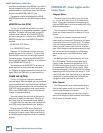
20
Compact Mixer Reference Guide
MIXER ANATOMY: CHAPTER 2
In recording applications, the TAPE INPUT jacks
provide a convenient way to play back your mixes
through the Control Room monitors. You’ll be able
to listen to a mix, then rewind and try another pass
without repatching or disturbing the mixer levels. In
sound reinforcement applications, you can use these
jacks to feed intermission music from a tape or CD
player without tying up a mixer channel.
If your mixdown recorder has balanced XLR out-
puts at the “pro” operating level of +4 dBu, then in
order to use the TAPE INPUTs, you will have to adapt
the connector type, as well as attenuating the signal
level by approximately 10 dB to avoid overloading.
If the recorder has an output level control, just turn
it down. Otherwise, you’ll need to purchase or build
an in-line attenuator. Alternately, you can connect
the recorder outputs through an XLR-TRS cable to a
channel line input.
Control and routing of the TAPE inputs varies
among models. Check the Control Room Source con-
trols in the Master section for particulars.
Auxiliary Return Inputs
Auxiliary Returns are line-level inputs designed
for connecting the outputs of effects devices. They
can also be used to connect extra line-level audio
sources. They’re balanced 1/4" TRS jacks, and will
accept signals from just about any pro or semi-pro
effects device on the market.
Typically, Auxiliary Returns from effects are routed
to the main L/R busses, but on certain models, they
can also be easily routed to AUX sends or subgroup
busses for more fl exibility.
Talkback Microphone Input
Some Mackie consoles are equipped with a con-
nector for a dedicated talkback microphone. A mic
plugged into this XLR jack can be routed to the main
mix, allowing you to speak to the audience (“And
now, let’s give a warm welcome to The SLOUGH-
TONES - YEAH!!”) or via AUX Sends 1-2 to stage
monitors or headphones (“Hey Flash! Your D string is
fl at!”).
The talkback mic has its own volume control and
routing switches located in the Master area of the
console.
The 8-Bus console has the talkback mic built
into the console. Just push the button and talk. In
addition to communication with the players, the
Talkback mic on the 8-Bus console can be sent to the
bus outputs to slate the tape. (“Purple Tears, take
seventeen.”)
The Onyx series mixers let you have it both ways.
There’s a built-in talkback mic as well as a connector
for an external talkback mic. It has 48 V phantom
power (always applied), so you can use a condenser
mic if you wish. Remember, though, that it’s not a
good idea to “hot plug” a mic to a connector that has
phantom power. Turn your mixer off before plugging
or unplugging your talkback mic whether it’s a con-
denser or a dynamic. It could save your mic!
Don’t feel left out if your console isn’t equipped
with dedicated talkback circuitry. You can accom-
plish the same thing by plugging a mic into a spare
input channel and routing it to wherever you want to
be heard.
Main Outputs
When we speak of the main outputs, we’re talking
about outputs from the left and right (stereo) bus-
ses. These outputs are controlled by the MAIN MIX
fader. This is where the fully mixed audio enters the
real world.
The MAIN OUTPUTS on XLR connectors are dif-
ferential, providing an extra 6 dB of output level, up
to +28 dBu.
The Main outputs are duplicated on impedance
balanced 1/4" TRS jacks. These provide up to +22
dBu output level, and work equally well when con-
nected to either balanced or unbalanced inputs.
When connected to a balanced input using a TRS
plug, they appear to the input as a balanced output
with nearly all the benefi ts of a differential, balanced
source. When connected to an unbalanced input,
they appear as an unbalanced source, at the same
output level as the balanced TRS outputs.
The PPM series mixers, since they’re intended
primarily for use with their own internal amplifi ers,
have only 1/4" unbalanced jacks for the main mix
outputs.
















